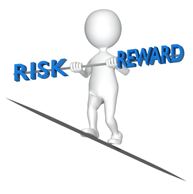Learn to Understand and Manage your Risk Tolerance
Make 2022 the year you learn to understand and manage your risk tolerance.

The beginning of a new year is an ideal time to evaluate your investment portfolio. Make time these first few weeks of 2022 to first review your long-term goals. This can be anything from finally tackling debt or building your emergency fund to stashing away money for retirement.
Think about what’s coming up for you in the next nine months: any major expenses (buying a house, paying a child’s tuition, a big vacation) to plan for?
You might find you are probably generally comfortable with your mix of investments, but maybe not. If that’s the case, make some adjustments. If you want to change it up, one of the most important things to consider is your risk appetite and personal risk tolerance. Your tax advisor can help with that. Our software tool, which allows a 10,000-foot view of your investment mix, can too.
No matter what your review reveals, there are a few initial things to understand about financial risk management and market risk.
First you should know all investments involve taking on risk. It’s important that you go into any investment in stocks, bonds or mutual funds with a full understanding that you could lose some or all your money in any one investment. But you can protect yourself by spreading your money among various investments, or diversification as they say in the portfolio management industry. That way if one investment loses money, your other investments will likely make up for those losses. How you diversify speaks to your risk tolerance. For example, aggressive investors will have a much higher allocation percentage of stocks versus bonds and money market funds. Alternatively, moderate investors, will have more balanced allocations in these asset classes to be commensurate with their moderate risk tolerance.
Market risk is also called a stock’s beta and it represents the sensitivity of an investment’s return. Put another way, beta measures the relationship between market movements and the effect fluctuations have on the prices of securities, for example. The IAM software can help you track beta values and gauge the market risk of your portfolio. If you’re uncomfortable with the beta measurements in your personal appraisal report. That way, you can consider replacing your existing securities or adding other investments. On the contrary, if your portfolio beta is really comfortable, you can probably tolerate more market risk – also by adding or replacing.
Your investment planning requires constant and careful consideration of all your options. Always be thinking about what diversification strategy and risk management plan makes sense for you. Diversifying doesn’t guarantee your investments won’t suffer if the market drops. However, it does improve the chances of not losing money. Or if you do lose, it won’t be as much as if you weren’t diversified.
Taking surveys, talking to your advisor and modeling the investment strategy of other funds are all good ways to measure your risk appetite. However, the best formula for calculating your level of financial risk tolerance is to know yourself. Listen to your gut instincts. Your risk profile is different from every other investor. Bottom line, knowledge is key. The more you understand, the better your ability to assess risk. An educated and confident investor is a better and more profitable investor.
The team here at Investment Account Manager knows the roadmap to financial security is winding, but there are many tools, including our software, to help you navigate the journey. We’re also offering a saving and investing guide from the SEC that can help you understand more about risk. You can download it here.